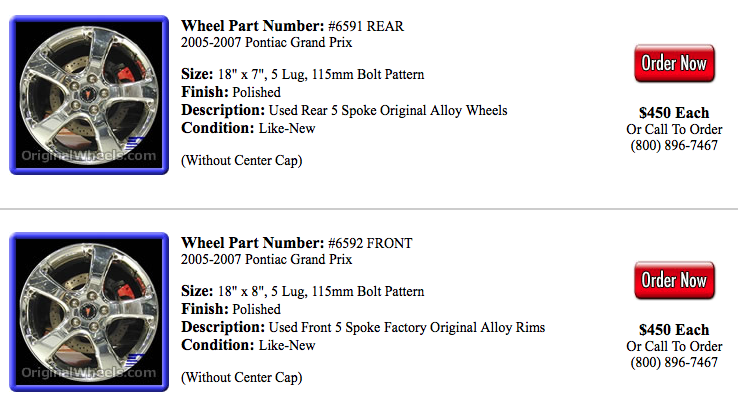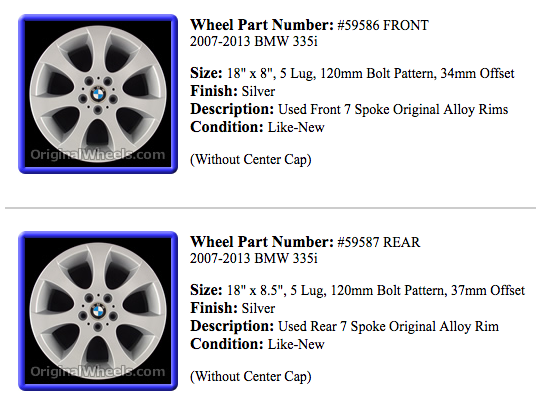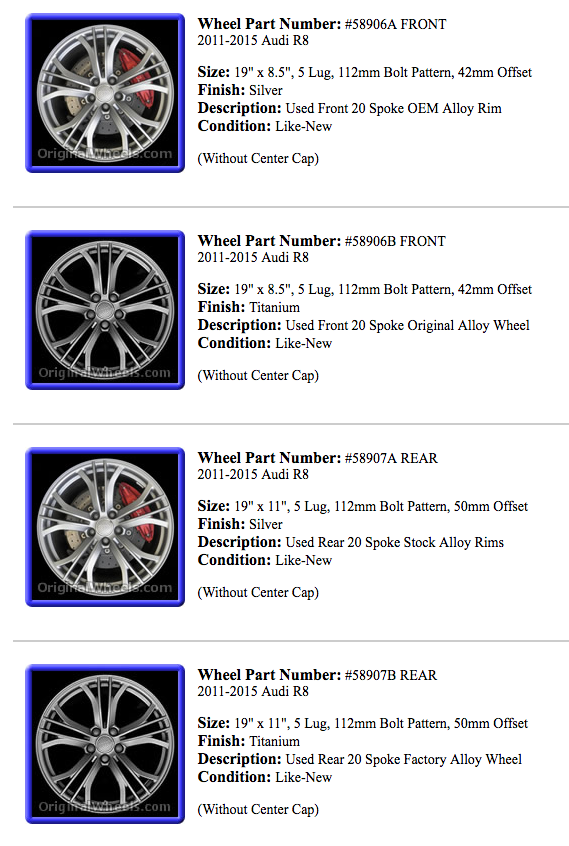When our customers call to purchase OEM wheels for their vehicle, sometimes we’ll ask them if their wheels are staggered or not. Many times, customers are unaware of what staggered means, much less know that their car has them! It all has to do with the size of the wheels. On most cars, both the front and the rear wheels are the same size all the way around. With staggered wheels, however, the rear wheels are wider than the front wheels, usually by either half an inch or a full inch (but it can also be more than that). Because the rear wheels of a staggered set are wider in size, in many cases you can put the front wheels in the rear if you desire, but not the other way around – rear wheels cannot go in the front. But to be sure, call your dealer to make sure this is something you would be able to do.
One thing to note is that there are cases where a rear wheel is not only wider, but bigger in diameter.
For these Chevy Corvette stock wheels, the rears are an inch larger in diameter, and an inch and a half wider. So it’s not just about width, although that is most commonly the difference between fronts and rears.
As a little aside, there are very rare examples of vehicles having larger/wider FRONT wheels. One such example are these Pontiac Grand Prix wheels:
 This is definitely just one of those weird, random exceptions, so don’t expect to see it very often.
This is definitely just one of those weird, random exceptions, so don’t expect to see it very often.
Why staggered wheels?
The staggering truth about staggered wheels is that their main purpose is cosmetic: people like the way they look. This is also why many people may opt for a car with a staggered setup as opposed to a standard – or square – setup. However, for those who are really into racing or high-performance driving, then a staggered setup may offer some more benefits. There are some who would say that staggered wheels offer better traction and handling, especially with cars like the Porsche 911 or Dodge Viper!
Sounds pretty nice, doesn’t it? But, like with all nice things, there are some downsides to staggered OEM rims. If you recall, we explained what it means to rotate your tires, and how this helps your tires last longer. Well, since you can’t put rear wheels in the front, this means you can’t rotate them. So, you’ll end up spending more money on tires in the long run. On top of that, you’ll have to buy different-sized tires to fit them all.
Taking all this into consideration, it’s up to you to decide if a staggered setup is right for you!
Staggered wheels on our website
 When purchasing a staggered set of used factory wheels from our website, we did our best to make it super easy for you! Next to the wheel part number, we put FRONT or REAR to identify which wheel it is. In the example above with the BMW 3 Series rims, it’s especially simple because the FRONT and REAR options were right on top of each other, along with their part numbers being in order. This isn’t always the case…
When purchasing a staggered set of used factory wheels from our website, we did our best to make it super easy for you! Next to the wheel part number, we put FRONT or REAR to identify which wheel it is. In the example above with the BMW 3 Series rims, it’s especially simple because the FRONT and REAR options were right on top of each other, along with their part numbers being in order. This isn’t always the case…
With these Audi R8 factory rims, it’s a little bit different. The FRONT and REARs aren’t directly on top of each other, you have to look a little further down to find the matching rims. And maybe it’s just me, but you would think that it’d make more sense for 58906B to be the REAR to match with the 58906A FRONT, rather than the REAR option being the next number over. While we don’t always know the reasoning behind Hollander’s numbering system, we hope the way it’s listed on our website isn’t so confusing. If anything, at least you can just match the pictures to each other!
Whether it’s a staggered setup or square setup you’re looking for, know that we’re the factory original wheel experts! If there’s anything else you’d like to know about staggered wheels that we didn’t cover here, or you want to purchase a set of stock rims, call us toll free at 1-800-896-7467 and we’ll gladly assist you!
Are staggered wheels right up your alley?
– Kathy
OriginalWheels.com



